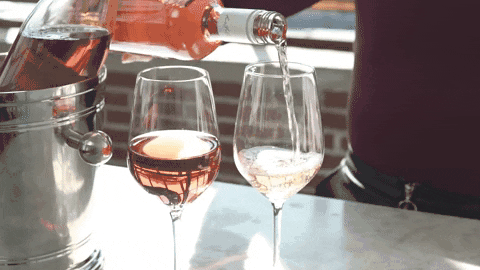
About 600 years before Christ, Greek colonists from Phocaea founded the colony of Massalia (known as the city of Marseille today), in the South-East of France, in the region today called Provence.

Marseille, port and main city in Provence, formerly known as Massalia
They brought with them wine and planted the first vineyards in France, making Provence the first French wine region.
The first wines ever made were rosé wine

Greek wines had a very light color. The Greeks would crush black grapes with their feet and the juice would directly be fermented without the must (skins, seeds, and stems of the fruit). Therefore, the coloring elements found in the grape skin could not give the color to the wine.

Traditional grape stomping (or crushing) using feet
Four hundred years later, the Romans took over and settled in Provence. They developed vineyards in the whole region, and while extending their empire further into Gaul, took the vines with them. This is how the wine regions of Rhône valley, Burgundy and Bordeaux were born.
The Roman wines were also made using black grapes which would be crushed and sent to fermentation right away, which would give a very clear pink color to the wine.

Grenache is one of the main grape varieties to produce rosé in Provence, as it has a thin and lightly pigmented skin
Rosé wines were the lords’ drink
Rosé wine is, therefore, the first known type of wine. During the Middle-Age, this wine was reserved to the lords and masters. Red wine, which was called "black wine" back then, was made with a long maceration of the grape skins in the juice. Too strong, it was given to the serfs, the lowest feudal class. White wine was almost non-existent.

Sénanque Abbey, built during the Middle-Age (9th century) in Gordes, Provence and surrounded by lavanda and vines
During the 14th century in France, it is known that wine was preferred over water, which was too polluted back then. Rosé wines were even given to sick patients in hospitals to cure their disease.
Rosé wines were also called « clairet »
During the 16th century, the pale red wine is also known as « clairet ». It was made the specialty of Bordeaux which exported massive amounts of this type of wine to England and Northern Europe. Many painters from that era would often represent glasses containing pale-coloured wine.

A painting by Flemish painter Peter Jacob Horemans representing oysters, a lemon and a carafe of pale wine (1769)
At the same time, demand in France evolved into a more colored and tannic wine. Red wine already existed and was mostly consumed by workers who needed the energy to work. Rosé wines were eventually replaced by red wines during the 18th century.
Provence and rosé wine, a modern love story

Lavanda and vineyards, a common landscape in Provence
It’s only during the 20th century that rosé wines made their come-back. With tourism development and the creation of railroads connecting Paris with the South of France, tourists arrived in Provence and fell in love again with local rosé wines.

People in Provence like to drink rosé wine while playing pétanque, a famous ball game
Rosé from Provence is the archetype of modern rosé style. It is pale pink in color, fruity and floral on the nose, light and refreshing on the palate. Today, Provence’s rosé wines represent 40% of the rosé sales in France and is the most famous region worldwide for the production of high-quality rosés.

L’apéritif, a moment for eating snacks and drinking wine before dinner
Rosé is consumed mostly during summer, at a chilled temperature. It is best to enjoy with friends at the end of the day, under the sun, and pairs marvellously well with soft cheeses, cold cuts or grilled meats.
Santé !


Founded in 2018 by Matthieu Ventelon, Hedonia is the first institution in China combining professional Wine and Etiquette expertise in the same training offer.
Find more information on our website : http://en.hedonia.cn